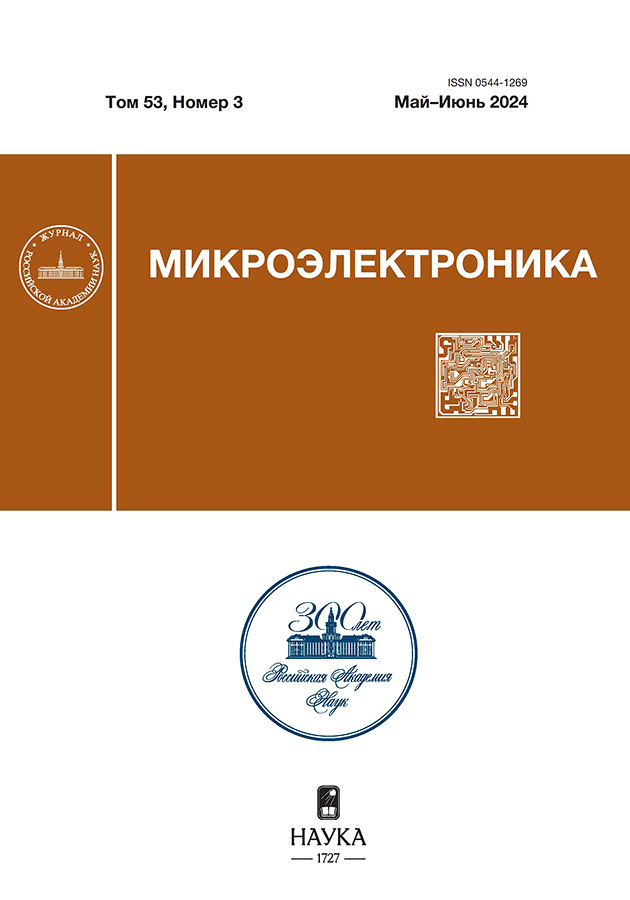Kinetics of electromigration mass transfer in micro- and nanoelectronics interface elements depending on the strength of thin-film junctions
- 作者: Makhviladze T.M.1, Sarychev M.E.1
-
隶属关系:
- Valiev Institute of Physics and Technology of Russian Academy of Sciences National Research Center “Kurchatov Institute”
- 期: 卷 53, 编号 3 (2024)
- 页面: 232-242
- 栏目: MODELING
- URL: https://rjonco.com/0544-1269/article/view/655224
- DOI: https://doi.org/10.31857/S0544126924030056
- ID: 655224
如何引用文章
详细
The theoretical model proposed earlier by the authors, which describes the interrelation of strength and electromigration (diffusion) properties of interfaces formed by joined materials, has been perfected and extended. Within the framework of the developed model, a linear relationship between the values of the work of reversible interface separation Wa and the activation energy of electromigration in the interface HEM was established. The coefficients of the obtained relation are estimated and compared with experimental data on the study of electromigration in a copper conductors covered with protective dielectrics. Using also the model developed earlier by the authors, which describes the dependence of the value on the concentrations of non-equilibrium lattice defects in the volumes of joined materials, a number of effects due to the influence of such defects on the processes caused by electromigration have been predicted and investigated. In the paper we obtained that by introducing non-equilibrium lattice defects in the volumes of bonded materials in the form of atomic impurities of interstition or substitution it is possible to effectively influence the characteristics of electromigration instability of the shape of the interlayer interface. For the introduction impurities, quantitative analytical estimates of the impurity concentration necessary for a significant change (both increase and decrease) in the characteristic rise time of the instability of the shape of the initially flat interface have been obtained.
全文:
作者简介
T. Makhviladze
Valiev Institute of Physics and Technology of Russian Academy of Sciences National Research Center “Kurchatov Institute”
编辑信件的主要联系方式.
Email: tarielmakh@mail.ru
俄罗斯联邦, Moscow
M. Sarychev
Valiev Institute of Physics and Technology of Russian Academy of Sciences National Research Center “Kurchatov Institute”
Email: sarych@yandex.ru
俄罗斯联邦, Moscow
参考
- Valiev K.A., Goldstein R.V., Zhitnikov Yu.V., Makhviladze T.M., Sarychev M.E. Nano- and micrometer-scale thin-film-interconnection failure theory and simulation and metallization lifetime prediction. Part 1: A general theory of vacancy transport, mechanical-stress generation, and void nucleation under electromigration in relation to multilevel-metallization degeneration and failure // Russ. Microelectronika. 2009. V. 38. No. 6. P. 404—427. doi: 10.1134/S106373970906002X.
- Tio Castro D., Hoofman R.J.O., Michelon J., Gravesteijn D.J. Void growth modeling upоn electromigration stressing in narrow copper lines // J. Appl. Phys. 2007. V. 102. P. 123515.
- Tu K.N. Recent advances on electromigration in very-large-scalt-integration of interconnects // J. Appl. Phys. 2003. V. 94. No. 9. P. 5451—5473.
- Lane M.W., Liniger E.G., Lloyd J.R. Relationship between interfacial adhesion and electromigration in Cu metallization // J. Appl. Phys. 2003. V. 93. Nо. 3. P. 1417—1421.
- Lloyd J.R., E.G., C.-K., R. Electromigration and adhesion // . 2005. V. 5. No. 1. Р. 113—118.
- Makhviladze T.M., Sarychev M.E. Effect of point defects on the electromigration rate at the interface of joined materials // Мikroelektronika. 2020. V. 49. No. 6. P. 450—458. doi: 10.31857/S0544126920050051.
- Makhviladze T.M., Sarychev M.E. Effect of lattice defects on the electromigration-induced instability of the interface between joined conductive materials // Mikroelektronika. 2022. V. 51. No. 6. P. 443—451. doi: 10.1134/S1063739722700160.
- Goldshtein R.V., Makhviladze T.M., Sarychev M.E. Influence of impurities on the work of separation along the interface of joined materials // Poverkhnost’. Rentgenovskie, Sinkhrotronnye i Neitronnye Issledovaniya. 2009. No. 12. P. 73—78. doi: 10.1134/S1027451009060196.
- Makhviladze T.M., Sarychev M.E. Instability of interfaces between conducting layers of integrated circuit elements under the influence of electric current and mechanical stresses // Physicheskya Mesomekhanika. 2022. V. 25. No. 1. P. 26—34. doi: 10.55652/1683-805X_2022_25_1_26.
- Ziman J.M. Principles of the theory of solids. Moscow: Fizmatlit, 1988. 416 p.
- Bernasconi R., Magagnin L. Ruthenium as diffusion barrier layer in electronic interconnects // J. Electrochem. Soc. 2019. V. 166. Nо. 1. P. D3219—D3225.
- Makhviladze T.M., Sarychev M.E. Influence of point defects on the initiation of electromigration in an impurity conductor // Mikroelektronika. 2021. V. 50. No. 5. P. 376—383. doi: 10.1134/S1063739721040077.
- Goldstein R.V., Makhviladze T.M., Sarychev M.E. Modeling the Kinetics of Lattice Defect Adsorption into the Interface of Joint Materials // Poverkhnost’. Rentgenovskie, Sinkhrotronnye i Neitronnye Issledovaniya. 2011. No. 8. P. 5—11. doi: 10.1134/S1027451011080064.
- Babichev A.P., Babushkina N.A., Bratkovskii A.M. et al. Fizicheskie velichiny: Spravochnik (Handbook of Physical Quantities), Grigor’ev I.S. and Melikhov E.Z., Eds., Moscow: Energoatomizdat, 1991.
补充文件









